Downloadable Image Samples
Manual lenses that do not send aperture data to the camera are somewhat problematic for lens reviews. Unless I made specific notes during my testing, which I did for the aperture series further down the page, there is no way for me to know what aperture was used for the test shots.
My advice? If you want to download the full-resolution samples for a closer look, concentrate more on the overall feel of the image. I have provided a set of images that do have the aperture noted on them, so you can examine the sharpness of those ones to create a rough sense of what was probably used for some of the other samples. This is the kind of mindset you have to use with this lens anyway. It’s not about being perfect, it’s about feel and character. Having no EXIF info is actually a helpful way to get your mind away from the specific camera settings and focus in on those less precise, but equally important image properties. Download and enjoy!
Aperture Series
With the Pergear 12mm lens being totally manual, the aperture value is not included in the image file’s EXIF information. In fact, the EXIF will not reveal any information about the lens at all. Below is a series of images taken at various aperture values so that you can evaluate image sharpness yourself across the aperture range. If you choose to download the full resolution samples of this series, the corresponding aperture value has been noted in the filename to help you. RAW Files are Sony ARW files from a Sony a9 II.

| Pergear 12mm Aperture | RAW | JPEG |
| f/2 | Download | Download |
| f/2.8 | Download | Download |
| f/4 | Download | Download |
| f/8 | Download | Download |
| f/16 | Download | Download |
| f/22 | Download | Download |
Additional Downloadable Samples
Unfortunately, because no EXIF data is recorded, there will be no indication of aperture values for the following sample images. Depending on your computer system and internet browser, you might have to right-click and “save as” on the download link.
Field curvature
I’ve noticed that the focus plane of the Pergear 12mm f/2 lens is not flat like in the Samyang/Rokinon or Fujinon. Instead, it is has concave shape with center closer to camera and edges further away. If you focus on flat target center – middle borders and corners will be always out of focus. Here is test example with Pergear 12mm at f/2 aperture.
As you can see boxes on sides are completely blurred, even edges of central box are blurred, because focus field is curving behind the box. In this next comparison, images taken from same tripod position, but side boxes are tilted in the first image and set back about an inch in the second. They still don’t catch the in-focus field, but you can see there is more detail in the boxes at the sides.
Hopefully these images will give you some understanding of the extent of the field curvature
It’s important to keep the field curvature in mind when shooting with the Pergear 12mm f/2 lens.
Bokeh
Speaking of close-up shots, here you can see quite pleasant and smooth out of focus rendering. I’m using Pergear 12mm on Fujifilm X-E2s focused to minimal 0.18m distance.
Even far objects look nicely blurred without too nervous-looking out of focus shapes.
Первые впечатления
Z fc — бесспорно красивая камера, с покрытием из кожзаменителя поверх видоискателя, сразу напоминающим всеми любимые зеркальные фотокамеры Nikon FM. Тем временем другие производители создают камеры в классическом стиле, что дает эффект того, что Z fc также напоминает несколько моделей Fujifilm, хотя у него законно есть собственная родословная, на которую можно ссылаться.
Наше первое впечатление от системы управления состоит в том, что она более последовательна, чем у аналогичной ретро-полнокадровой зеркальной камеры Df. И у нее много общего с Nikon Z 50, одной из наших любимых камер APS-C (и, безусловно, одной из самых дорогих).
У нас все еще есть опасения по поводу уровня поддержки Nikon DX-оптики с байонетом Z, но выпуск 28mm F2.8 обеспечивает приятный (хотя и не особенно быстрый) вариант 42-мм эквивалента, который хорошо сочетается с камерой с точки зрения размера и цены, а также эстетики.
Компания Nikon подчеркивает, что вы можете установить все ее полнокадровые объективы с байонетом Z на Z fc, что расширит ваши возможности, но закрытый мир с байонетом Z означает, что нет эквивалента, например, у доступной Tokina. Также в качестве примера можно вспомнить объективы 23, 35 и 56mm F1.4 для байонетов APS-C Canon, Sony и Fujifilm, интересную тройку объективов DC DN от Sigma.
В конечном итоге, это может не иметь принципиального значения. Значительная часть пользователей Z fc может быть полностью довольна гибкостью, обеспечиваемой набором зум-объективов или анонсированным Z DX 18-140mm F3.5-6.3 VR, а еще большее количество найдет, что такие объективы, как Nikon 28mm F2.8 или 24mm F1.8 являются отличными решениями во многих ситуациях с возможностью решиться перейти на полный кадр в будущем.
Design and Handling
The lens comes with a surprisingly good protective pouch.
When the lens arrived from Pergear for testing, I didn’t have any great expectations for the build quality. After all, this lens costs just $165.99 and through years of buying professional lenses I have been conditioned to think that you must spend many hundreds of dollars to get anything that might feel great in the hand.
I was wrong. Upon removing the lens from the (included) softly padded lens bag, I found a solidly built lens with an all-metal casing. To my surprise, it even had a robust metal lens mount. Something which is far more preferable than the plastic mounts usually found on cheaper OEM lenses from the likes of Canon, Nikon and Sony.
The metal lens hood is fixed to the camera and feels sturdy. This is a hood that will give ample shading to the front element, while at the same time offering considerable physical protection from bumps and dings. I like its design a lot, and I far prefer the ability to place a centre-pinch lens cap inside the metal lens petals, compared to much larger custom lens caps that encompass the entire hood.
Looks are, of course, subjective. But I personally think this lens looks fantastic. In fact, I was so enamoured by its retro styling that I think I went a little overboard with the product photos in this review! Please take the time to click on some of the product shots to enlarge them on your screen and enjoy some of the lovely lines this lens creates.
Perhaps more important than the look of this lens is the feel of the manually operated focus and aperture rings. With no electronic contacts on the lens mount to communicate with the camera, you are relying on these to control the lens and create your images. Thankfully, both rings are beautifully dampened. They remind me of a lot of the old manual DSLR lenses from the pre-digital days. The focus ring, in particular, is extremely enjoyable to use, and it made me wonder why so many of the focus rings feel like crap on my much more expensive lenses.
Of course, you can’t expect perfection at this price. If you look very closely you will see minor flaws in the black paint, and the presence of a screw right in the middle of the focus ring is aesthetically unfortunate. However, you can colour me more than impressed with the quality to price ratio of this lens. It is punching well above its weight, and I can’t see anyone having anything other than a smile on their face when they first unpack this purchase and roll it around in their hands. We’re off to a good start!
Early Conclusions
The Pergear 12mm f/2 is an affordable ultra-wide lens with great build quality and fast aperture. It has good center sharpness, but the plane of focus is not flat which often makes borders and corners look very soft. As such, you may often need to stop down aperture and compose image in the way to fit objects into spherical DOF area.
Close-up focus of 0.18m is great to have. I personally think that image quality fits the Pergear 12mm price. If you need flat field with great sharpness in border/corners wide open then try more expensive Samyang/Rokinon 12mm f/2 lens. It is possible to take good quality pictures with Pergear 12mm though, if you learn its optical limitations and properly utilize field curvature. I’ll keep shooting with it and follow up with more on my website soon.
You can buy the Pergear 12mm f/2 off their website here
Contribute to 35mmc for an Ad-free Experience
There are two ways to experience 35mmc without the adverts:
Paid Subscription — £2.99 per month and you’ll never see an advert again! (Free 3-day trial).Subscribe here.
Content contributor — become a part of the world’s biggest film and alternative photography community blog. All our Contributors have an ad-free experience for life.Sign up here.
Pergear 12mm lens mechanics and ergonomics
The Pergear 12mm f/2 focus ring has a very different texture compared to the aperture ring. I find this to help to quickly understand which ring you are rotating while not looking at them. Though if you are used to shooting with Voigtlander 50mm f/1.5 (M mount) or Voigtlander 35mm f/1.7 Ultron it will be not as convenient. The Voigtlander lens has a scalloped focus ring at the position of Pergear 12mm f/2 aperture ring and the aperture ring has similar texture and position as Pergear focus ring. As such, right after shooting with one of those lenses, switching to Pergear 12mm f/2 might seem confusing.
Focusing is very smooth with the Pergear 12mm f/2, and due to it being such a wide angle, it is also very quick to operate due to the very short movement of the optical core. The close focusing distance is just 0.18m which allows for ultra-wide close-up photos.
It’s also important to add, that the focus ring has three metal bolts which allow precise tuning of focus ring position. This means you can calibrate infinity focus very easy – something I find beneficial in many Chinese lenses.
Aperture control
Of course at this price point it’s hard to expect the aperture ring to be clicked, and it’s not. The good thing is that ring rotation requires noticeable effort and moves very smooth as well. The lens has 12 curved aperture blades for nice round out of focus highlights even at closed diaphragm positions.
Lens size
Personally I prefer a lens to be very compact, and typically I’m not using lens hoods unless the front element is protruding out of the front of the lens. This is not the case with the Pergear 12mm f/2 lens. The front element sits deep enough to not touch the surface if if you placed it face down on the surface. The filter diameter is 62mm, so I’ll probably attach a protective filter later. It is much easier to wipe out flat filter surface compared to the more complex process of cleaning an almost spherical front optical element.
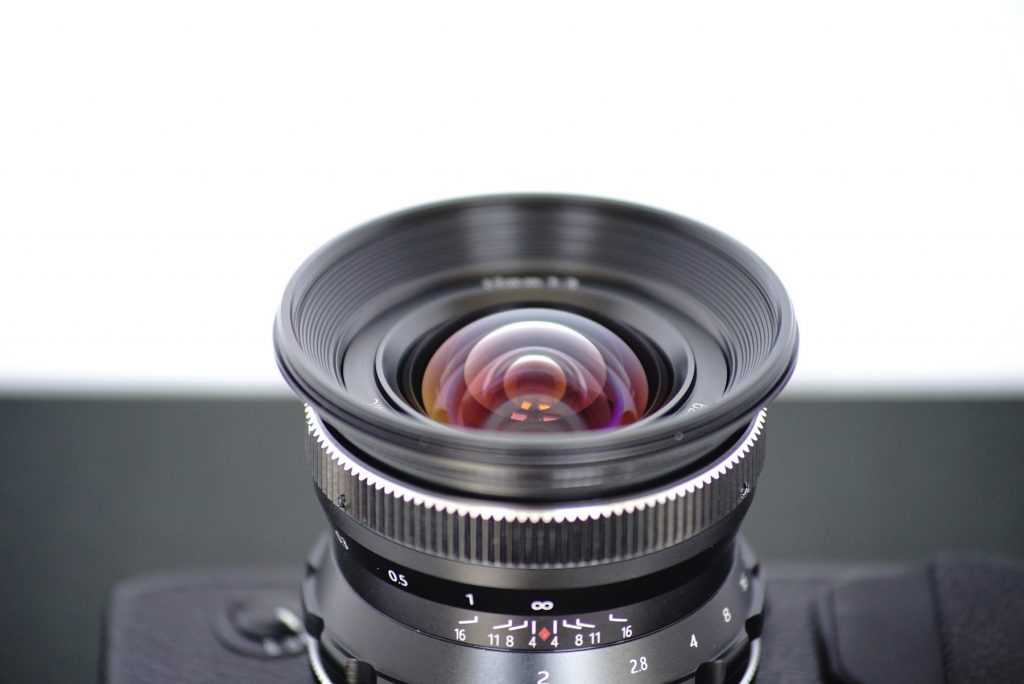
Here is the Pergear 12mm f/2 lens size comparison to two other alternative options for Fuji X mount: Rokinon/Samyang 12mm f/2 (to the left) and Fujinon XF 14mm f/2.8 lens (to the right).
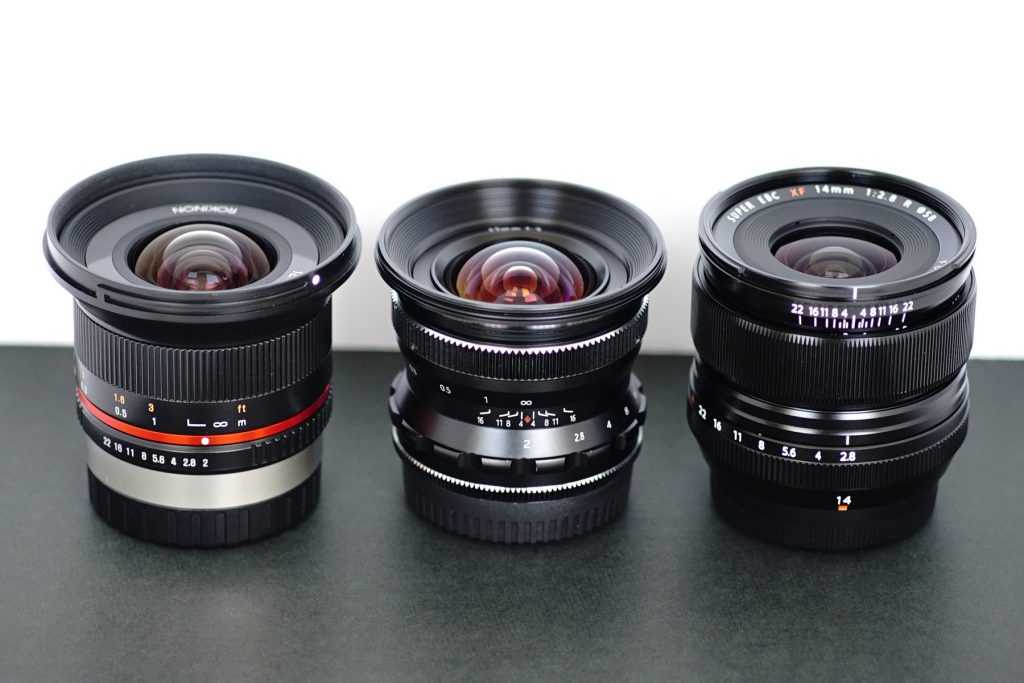
I like the skinny and “vintage” look of Pergear 12mm f/2 lens – it is all metal and feels quite solid and durable.
Setting Up Your Camera For This Lens
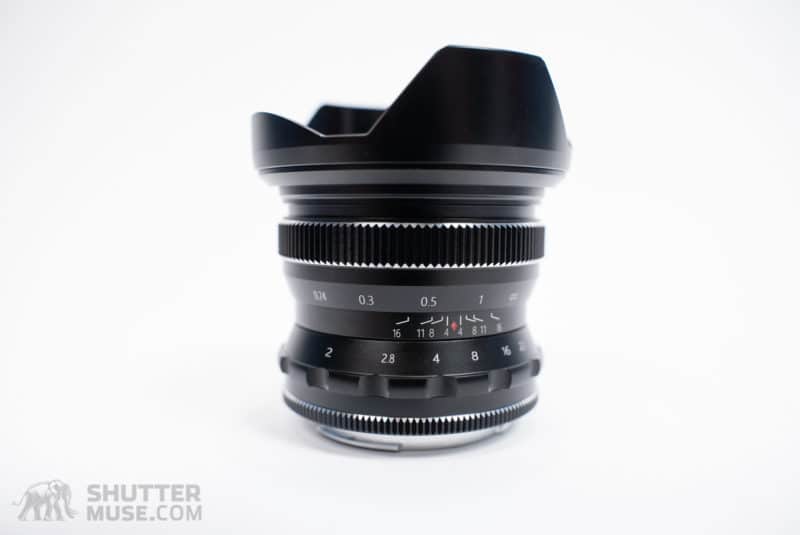
Before I get stuck into the optical characteristics of the lens, I want to include some notes on setting up your camera to function correctly with a lens like this. The Pergear 12mm lens does not have any electronic contacts to enable communication with your camera. This means your camera might not be aware that there is a lens attached, and the default setting for most cameras is that you cannot take a photo without a lens.
Shutter Release Without Lens
To solve this, you’ll need to dig into the menu system to find the setting which enables you to trigger the shutter without a lens attached. Remember, while we know there is a lens attached, your camera does not.
- Canon cameras: Menu > Custom Functions > Release shutter w/o lens > ON
- Sony cameras: Menu > Camera Settings2 > Release w/o Lens > ENABLE
- Nikon: Not necessary to change any options. As far as I know, it will work.
Note: Camera manufacturers are changing their menu systems all the time. There is a chance that setting location and wording are not an exact match for the ones listed above. Hopefully, it gives you enough of a clue to find what you are looking for.
Crop Mode
The Pergear 12mm lens covers the APS-C sensor format. If you are using an APS-C camera, move on, there’s nothing to see here. If, however, you are using a full-frame camera, you will need to enable your camera’s crop mode so that you do not get severe mechanical vignetting. This will force your camera to only capture the centre portion of the sensor that is covered by this lens.
Mirrorless cameras have a massive advantage over older DSLRs in this instance, because the viewfinder image can also be cropped to show exactly what you are framing.
- Canon: Menu Page 1 > Cropping/Aspect Ratio > 1.6x
- Sony: Menu > Camera Settings1 > APS-C/Super 35 > ON
- Nikon: Photo Shooting Menu > Choose image area > DX
Note: At least on Sony cameras, crop mode results in a smaller file. Some people assume that you can go back into Lightroom and remove the crop afterwards, but that’s not the case. The crop is baked into the RAW dimensions.
Note 2: Although Sony cameras do have an “Auto” option in the APS-C/Super 35mm menu section, this only works with APS-C lenses that have electronic contacts. Leaving it in Auto will not crop the frame for the Pergear lens.
Focus Assist
This lens is manual focus only. Most people will want to use some or all of the focus assist tools that are available on modern cameras. Usually, these can be mapped to custom function buttons for quick access when using this lens.
The two most common focus assist tools are Focus Peaking and Focus Magnifier. Focus peaking highlights the edges of objects that are currently in focus. Usually there are some options to change the peaking colour in the viewfinder, as well as setting the threshold.
Focus magnification zooms in on a portion of your frame, allowing you to get a better idea of exactly which areas are in focus. There are often different zoom levels such as 5x and 10x. On some cameras, peaking can be combined with magnification.
Check the manual for your camera to find out more about the implementation of these features, and how you can assign some, or all of them to custom function buttons for quick recall.
Conclusion
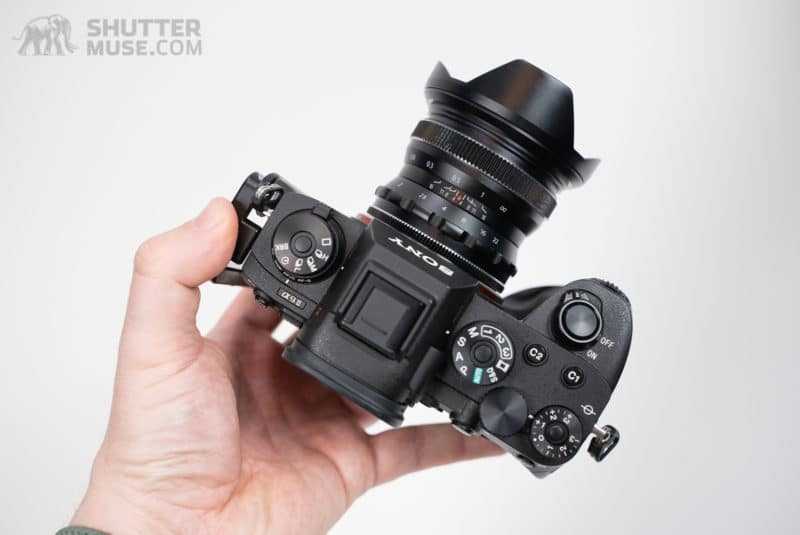
The Pergear 12mm lens is a somewhat difficult lens to categorize. Optically, it’s far from what we would call perfect, but it somehow manages to create a look that really endears itself. It doesn’t even try to be perfect, and the character of the optical flaws somehow ends up being fun and hugely engaging if you pay attention to them while you shoot.
Instead of discovering minor flaws only when you are pixel peeping at home, the optical flaws of this lens are in your face right through the viewfinder. And the result is that you can work with them in your composition, and have fun with them to create an image that looks very different from the clinical look of most current professional lenses. I wouldn’t pick this lens for critical landscape photography where uniform sharpness is generally appreciated, but it makes a fun walkaround option for wide-angle travel and street photography.
Image samples
My first impressions are that the Pergear 12mm f/2 lens is decently sharp in the center wide open, but borders and corners are noticeably soft. That is due to curved focus field area – something I will come to in a moment.



These Images are taken with the Fujifilm X-E2s camera, mostly @ f/2, and sometimes @ f/2.8




And some vertical shots.


Briefly comparing to Rokinon 12mm f/2
Next I have two shots taken with the Pergear 12mm f/2 lens (first shot), and Rokinon 12mm f/2 (second shot). They reveal noticeable differences. The real field of view of the Pergear 12mm f/2 lens is more narrow compared to the Rokinon. Also, the level of details are significantly higher in the image corners of the Rokinon.
This is due to more expensive and advanced optical correction involved in its design. That’s why the Rokinon/Samyang is so often picked by fans of astrophotography. Though Pergear is a much affordable lens, and has its optical limitations due to production cost. It is important to understand this difference when making decision regarding shooting scenes you plan to capture. To have higher level of details you’ll obviously need to stop down Pergear 12mm lens aperture more.
Bokeh
Speaking of close-up shots, here you can see quite pleasant and smooth out of focus rendering. I’m using Pergear 12mm on Fujifilm X-E2s focused to minimal 0.18m distance.

Even far objects look nicely blurred without too nervous-looking out of focus shapes.

Early Conclusions
he Pergear 12mm f/2 is an affordable ultra-wide lens with great build quality and fast aperture. It has good center sharpness, but the plane of focus is not flat which often makes borders and corners look very soft. As such, you may often need to stop down aperture and compose image in the way to fit objects into spherical DOF area.
Close-up focus of 0.18m is great to have. I personally think that image quality fits the Pergear 12mm price. If you need flat field with great sharpness in border/corners wide open then try more expensive Samyang/Rokinon 12mm f/2 lens. It is possible to take good quality pictures with Pergear 12mm though, if you learn its optical limitations and properly utilize field curvature. I’ll keep shooting with it and follow up with more on my website soon.
Image samples
My first impressions are that the Pergear 12mm f/2 lens is decently sharp in the center wide open, but borders and corners are noticeably soft. That is due to curved focus field area – something I will come to in a moment.
These Images are taken with the Fujifilm X-E2s camera, mostly @ f/2, and sometimes @ f/2.8
And some vertical shots.
Flare
Using hood is important, thought there are some shots where you’d like to add direct sun light -in doing so, it will cause noticeable flare. Some may not like them, but personally I don’t mind including flare sometimes on pictures to emphasize brightness of the light.
However for some angles there are too much flares.
Briefly comparing to Rokinon 12mm f/2
Next I have two shots taken with the Pergear 12mm f/2 lens (first shot), and Rokinon 12mm f/2 (second shot). They reveal noticeable differences. The real field of view of the Pergear 12mm f/2 lens is more narrow compared to the Rokinon. Also, the level of details are significantly higher in the image corners of the Rokinon.
This is due to more expensive and advanced optical correction involved in its design. That’s why the Rokinon/Samyang is so often picked by fans of astrophotography. Though Pergear is a much affordable lens, and has its optical limitations due to production cost. It is important to understand this difference when making decision regarding shooting scenes you plan to capture. To have higher level of details you’ll obviously need to stop down Pergear 12mm lens aperture more.
Pergear 12mm f/2 lens vs. Rokinon 12mm f/2
Pergear 12mm lens mechanics and ergonomics
Just look how small this Pergear 12mm f/2 ultra wide-angle lens is on a Fujifilm X-E2s camera.
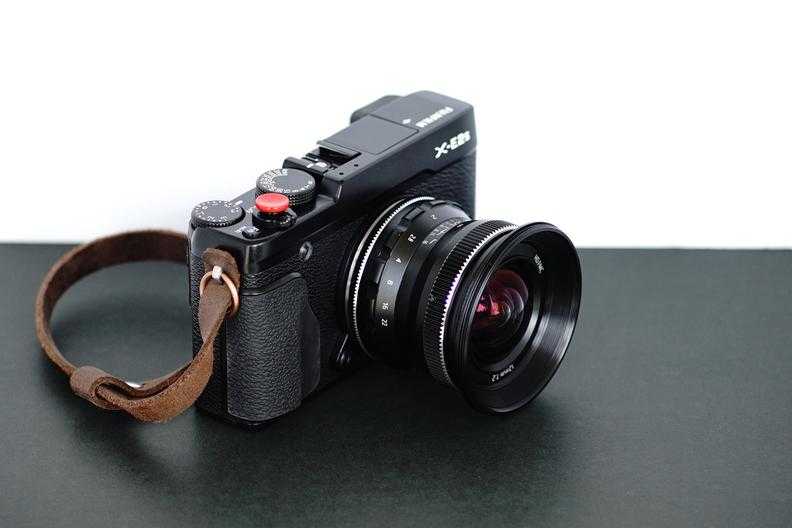
Focusing
The Pergear 12mm f/2 focus ring has a very different texture compared to the aperture ring. I find this to help to quickly understand which ring you are rotating while not looking at them. Though if you are used to shooting with Voigtlander 50mm f/1.5 (M mount) or Voigtlander 35mm f/1.7 Ultron it will be not as convenient. The Voigtlander lens has a scalloped focus ring at the position of Pergear 12mm f/2 aperture ring and the aperture ring has similar texture and position as Pergear focus ring. As such, right after shooting with one of those lenses, switching to Pergear 12mm f/2 might seem confusing.
Focusing is very smooth with the Pergear 12mm f/2, and due to it being such a wide angle, it is also very quick to operate due to the very short movement of the optical core. The close focusing distance is just 0.18m which allows for ultra-wide close-up photos.
It’s also important to add, that the focus ring has three metal bolts which allow precise tuning of focus ring position. This means you can calibrate infinity focus very easy – something I find beneficial in many Chinese lenses.
Aperture control
Of course at this price point it’s hard to expect the aperture ring to be clicked, and it’s not. The good thing is that ring rotation requires noticeable effort and moves very smooth as well. The lens has 12 curved aperture blades for nice round out of focus highlights even at closed diaphragm positions.
Lens size
Personally I prefer a lens to be very compact, and typically I’m not using lens hoods unless the front element is protruding out of the front of the lens. This is not the case with the Pergear 12mm f/2 lens. The front element sits deep enough to not touch the surface if if you placed it face down on the surface. The filter diameter is 62mm, so I’ll probably attach a protective filter later. It is much easier to wipe out flat filter surface compared to the more complex process of cleaning an almost spherical front optical element.
Here is the Pergear 12mm f/2 lens size comparison to two other alternative options for Fuji X mount: Rokinon/Samyang 12mm f/2 (to the left) and Fujinon XF 14mm f/2.8 lens (to the right).
I like the skinny and “vintage” look of Pergear 12mm f/2 lens – it is all metal and feels quite solid and durable.
You can read more about build quality and internal mechanics in my Pergear 12mm f/2 disassembly article.





























